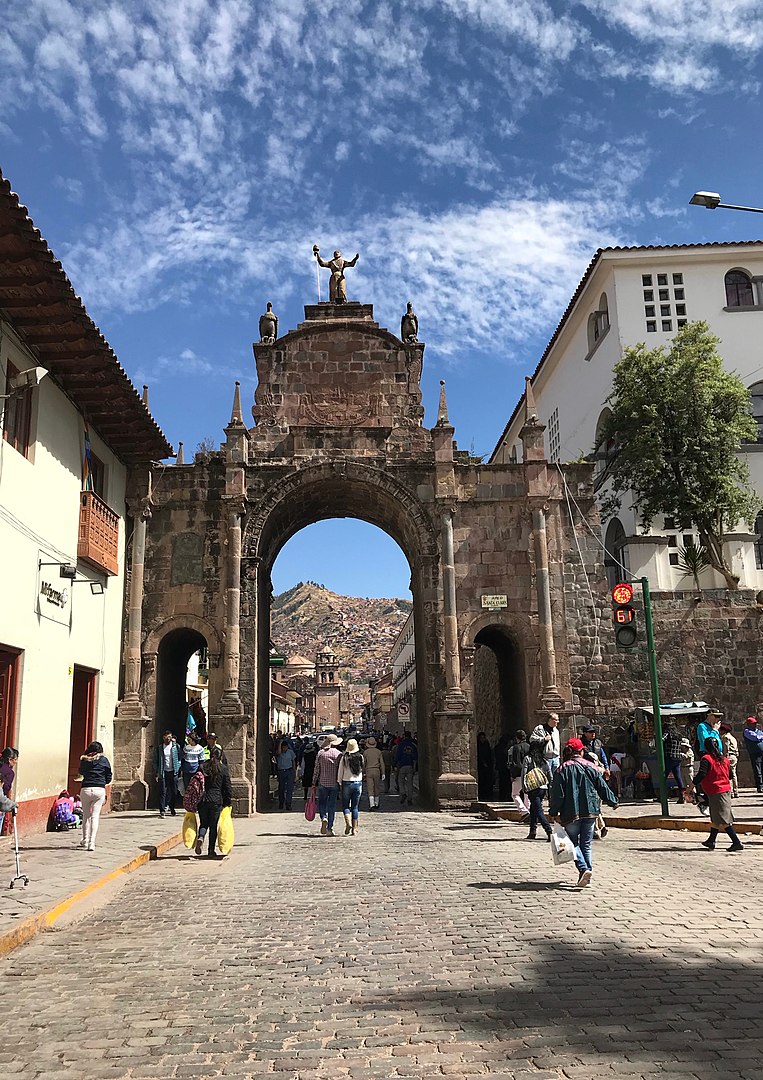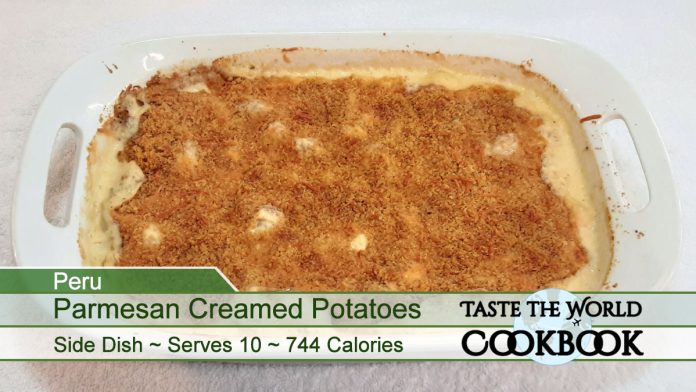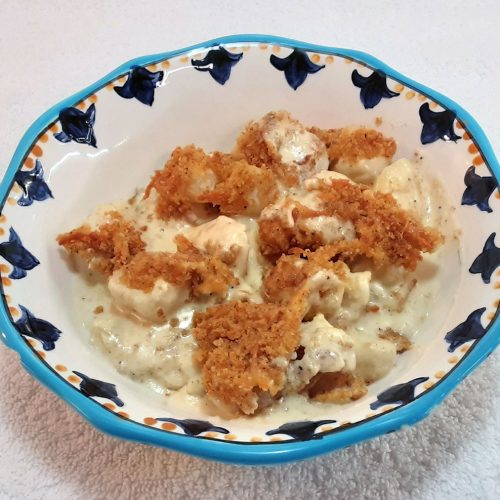Hailing from the vibrant culinary scene of Cusco, Peru, our Parmesan Creamed Potatoes offer a comforting fusion of simplicity and indulgence. This side dish takes the humble potato, a staple ingredient in many cuisines, and transforms it into an elegant accompaniment that pairs well with a variety of main dishes.
At the heart of this recipe are the potatoes – cooked until soft and tender, they provide a hearty base for the dish. Each potato, flawlessly prepared, is ready to soak up the rich flavors of the sauce, ensuring every bite is an explosion of taste. The potatoes offer a pleasing contrast between their fluffy interior and slightly firm exterior, a testament to the careful cooking process.
But the true highlight of this dish is the luxuriously thick and creamy sauce, in which the potatoes are generously smothered. This is where the dish gains its depth of flavor. The sauce is then topped with a lavish sprinkle of parmesan cheese, which, as it bakes, forms a tantalizingly crispy top layer. This final touch not only adds a sharp flavor contrast but also introduces a delightful textural element to the Parmesan Creamed Potatoes. With every bite, you’ll appreciate the harmony of soft potatoes, creamy sauce, and crispy parmesan crust, making this dish a true celebration of culinary balance.
Table of contents
The Many Avatars of Potatoes: Exploring Cooking Techniques
Potatoes have earned a reputation for being one of the most versatile ingredients in the kitchen. This versatility comes to light when we consider the array of cooking methods that Diana Leet from Finding Lovers shares, totaling an impressive 61 ways to prepare potatoes. Every method brings out a unique aspect of the potato, transforming this humble ingredient into a culinary masterpiece in its own right. From the simple to the intricate, these cooking techniques reveal the potato’s endless potential.
Some of the most popular ways to enjoy potatoes include creamed potatoes, baked potatoes, and mashed potatoes. Creamed potatoes introduce a layer of indulgence, creating a dish that is both comforting and sophisticated. Baked potatoes, on the other hand, showcase the potato’s ability to stand alone, its crispy skin and fluffy interior proving satisfying on their own. Meanwhile, mashed potatoes represent comfort food at its finest, providing a canvas for flavors ranging from garlic and herbs to cheese and cream.
Of course, there are also more exotic potato dishes that push the culinary boundaries, such as Lionized Potatoes. These unique preparations often draw from diverse culinary traditions, resulting in dishes that offer an exciting and delicious departure from the norm. Regardless of the cooking method you choose, there’s no denying the remarkable adaptability of potatoes in the culinary world.
Proper Storage and Reheating of Potatoes: Maintaining Freshness and Flavor
Potatoes are wonderful when eaten fresh, but leftovers need not go to waste if stored correctly. Proper storage can keep leftover potatoes fresh and tasty for about 3 to 4 days. It’s crucial to use an airtight container for storing potatoes to protect them from exposure to air and moisture, which can lead to spoilage. Keeping the container in the fridge further helps in maintaining their quality, ensuring you can enjoy your potato dishes a little longer.
Reheating potatoes requires some care to preserve their texture and flavor. Dishes such as Parmesan Creamed Potatoes can easily dry out if not reheated properly. Covering the baking dish with aluminum foil and reheating in the oven at 350F can help retain the dish’s moisture, ensuring it’s warmed through without becoming dry or overcooked.
By adopting these methods for storing and reheating potatoes, you can extend their shelf life and retain their quality. This not only helps in reducing food waste but also lets you enjoy your favorite potato dishes whenever you please.
A Historical Journey of the Potato: From Ancient Cultivation to Modern Production
The history of the potato is one of endurance and adaptability. Originating with the Inca Indians in Peru around 10,000 years ago, this hardy tuber has since traveled across continents and centuries to become a global staple. The Spanish Conquistadors, upon their conquest of Peru in 1536, were the first Europeans to encounter the potato. They recognized its potential and carried it back to Europe, marking a significant milestone in the potato’s journey.
The potato’s voyage continued when Sir Walter Raleigh started cultivating it on his vast farm near Cork, Ireland, in 1589. However, it would take nearly four decades for the potato to spread to the rest of Europe. Over time, this versatile crop found its way into fields and kitchens across the continent, its popularity growing with each passing year.
Today, Idaho stands as a testament to the potato’s widespread appeal, being the largest producer of potatoes in the world. The development of the Russet Burbank variety in 1872 marked a significant advancement in potato cultivation, fueling Idaho’s thriving potato industry. This resilient tuber, once a humble staple of ancient Peru, now feeds millions worldwide, demonstrating its invaluable contribution to our food systems.
Cusco, Peru: A Metropolitan Blend of History and Culture
Nestled in the heart of the Peruvian Andes, Cusco reigns as the capital of the Cusco Region and Province. With a population of 428,450 as of 2017, it stands as Peru’s seventh most populous city. This city, perched at an elevation of around 11,200 feet, thrums with life against a backdrop of mountains.





Cusco’s remarkable blend of ancient and modern won it the title of a World Heritage Site by UNESCO in 1983. Its intricate blend of Inca history and Spanish colonial influence create a tapestry of culture that is as intriguing as it is beautiful. From its narrow, cobbled streets to its stunning cathedrals, every inch of the city is steeped in history.
Tourism plays a significant role in the city’s economy, with nearly 2 million visitors arriving each year to experience its magic. Further cementing its historical significance, the Constitution of Peru designates Cusco as the Historical Capital of Peru, a title that reflects the city’s deep roots and its central role in the country’s history.
Cusco: Tracing the Footprints of Inca and Spanish History
The history of Cusco is a saga of civilizations, conquests, and resilience. The Killke people, who occupied the region between 900 and 1200 CE, were the city’s earliest known inhabitants. However, the 13th century marked a dramatic shift when the Inca arrived and established their reign.
During the Inca Civil War, the city fell under Huáscar’s sphere of influence but was later captured by Atahualpa’s generals in the Battle of Quipaipan in April 1532. Less than two years later, Spanish explorers invaded and seized control of Cusco, wielding their superior military technology to subdue the Inca stronghold.
Under Spanish rule, Cusco transformed into the heart of colonization and the spread of Christianity in the Andean world. Agriculture, cattle raising, and mining flourished, as did trade with Spain, enriching the city. Spanish colonists left their mark in the form of numerous churches, convents, a cathedral, a university, and an archdiocese, many of which stand to this day.
Exploring Cusco: The Inca Capital as a Tourist Destination
As the former epicenter of the Inca Empire, Cusco now charms visitors with its archaeological relics and Spanish colonial architecture. At the city’s core lies the Plaza de Armas, a bustling square framed by arcades, carved wooden balconies, and fragments of ancient Incan walls. The Santo Domingo Convent, a baroque structure built on the Incan Temple of the Sun, houses a treasure trove of archaeological remnants of Inca stonework.
Cusco is a city where every street corner whispers tales from the past. Meandering through lanes with evocative names like “Coffin”, “Seven Serpents”, and “Harpies”, you encounter a city where time seems to have paused, where every nook offers a slice of history, and where the stones feel alive with centuries of tales.
The city retains an ancestral magic that enthralls the thousands of visitors who flock here annually. As the acknowledged historic capital of Peru, Cusco continues to be known as the navel of the Earth—a testament to its enduring significance in world history.
A Taste of the Andes: Discovering the Cuisine of Cusco
Cusco, as the capital of the Inca Empire, was a crucial agricultural hub. It was a natural reserve for thousands of native Peruvian species, including around 3,000 varieties of potato cultivated by the Inca. The city’s cuisine reflects this rich agricultural heritage, with traditional Andean ingredients taking center stage.
In Cusco today, you’ll encounter fusion and neo-Andean eateries where cuisine is crafted with contemporary techniques, yet stays rooted in tradition. These establishments offer a gastronomic adventure, creating dishes that weave together the flavors of traditional Andean ingredients with international influences.
Cusco’s culinary scene is an integral part of its identity. Each dish tells a story, from the farms and markets to the tables in bustling restaurants or homely kitchens. Through its cuisine, Cusco offers another window into its unique cultural tapestry.
– Featured Restaurant –
Marcelo Batata Restaurante
C. Palacio 121, Cusco 08002, Peru

OUR NICHE IS CREOLE AND ANDEAN CUISINE: We raise the flavors of that beautiful mixture of races that have allowed us to create an endless number of flavors that each Peruvian carries in their veins.
We are fans of chili peppers, native potatoes, passion flowers, avocados, rice, and corn. Slow cooks and abrasive stoves are our passion.
Mastering the Art of Parmesan Creamed Potatoes: A Step-by-Step Guide
Creating a dish of Parmesan Creamed Potatoes is a culinary adventure that combines simplicity with exquisite flavor. This recipe, while it requires a little over an hour of your time, is not a test of skill but a journey of taste. It’s been called the best potato casserole dish for good reason; every bite carries a melange of creaminess, crunchiness, and a rich blend of flavors that will surely tantalize your taste buds.
To begin, gather your cooking utensils and ingredients. The anticipation of preparing this dish can be as satisfying as the cooking process itself. Imagine the transformation of each ingredient as you combine them, envision the amalgamation of flavors, and feel the excitement of creating a dish that is not just food, but an experience.
As you follow through each step of this recipe, remember that you are not just cooking but creating. Each stir, each simmer, and each bake is a personal touch that you add to the dish. By the time you pull the casserole dish out of the oven, you would have not only made a delicious dish of Parmesan Creamed Potatoes but also participated in a delightful culinary journey.
Gearing Up for Your Parmesan Creamed Potatoes: Ingredients and Tools Checklist
Preparing for the cooking process is crucial in creating a seamless culinary experience. Equip yourself with all the necessary tools and ingredients before embarking on your Parmesan Creamed Potatoes journey. Having everything ready and within reach helps streamline the cooking process, keeping it enjoyable and hassle-free.
Equipment Needed
- Boiling Pot or Dutch Oven
- Mixing Bowl
- Casserole Dish
- Mixing Spoons
- Measuring Cups
- Pot Holders
For the Potatoes
- 3 lbs russet potatoes peeled and cut into 1-inch chunks
- 3 cups heavy cream
- ¼ tsp baking soda
- ¼ tsp black pepper
- ½ cup heavy cream
- 6 tbsp unsalted butter cut into 6 pieces
For the Topping
- ½ cup parmesan cheese grated
- ½ cup panko bread crumbs
- 2 tbsp unsalted butter melted
Cooking Directions for Parmesan Creamed Potatoes
Time needed: 1 hour and 10 minutes
How to Cook Parmesan Creamed Potatoes
- Preheat the Oven
Adjust oven rack to middle position and heat oven to 375°F.
- Chop the Potatoes
Peel and cut your potatoes into one-inch squares.
- Cook the Potatoes
Combine potatoes, 3 cups cream, baking soda, 2 teaspoons salt, and 1 teaspoon black pepper in a large saucepan or Dutch oven. Bring to a boil over medium heat and reduce heat to low.
- Simmer the Potatoes
Cook at a bare simmer, stirring often, until potatoes have softened to fork-tender but not crumbling, about 25-30 minutes.
- Mix the Breading
In a small bowl, combine Parmesan, bread crumbs, melted butter, and ¼ teaspoon salt and set aside for later use.
- Spray the Casserole Dish
Spray a 13×9-inch casserole dish with nonstick cooking spray.
- Remove from Heat
Remove the potatoes from the heat and add the remaining ½ cup cream and 6 tablespoons butter. Stir in gently until the butter has melted, about 1 minute.
- Transfer to Casserole Dish
Pour the potato mixture into the prepared casserole dish and sprinkle evenly with the Parmesan/Panko mixture.
- Bake to a Bubbling Perfection
Bake, uncovered, until golden brown and bubbling around edges, 20-30 minutes.
- Cool and Serve
Allow the dish to cool for 10-15 minutes before serving.
These Parmesan Creamed Potatoes, boasting their delightful creaminess, make a perfect side dish not only for special occasions like Thanksgiving and Christmas, but also anytime you find yourself craving a dose of deliciously creamy potatoes.
If you liked this dish please Rate This Recipe and leave a comment.
Parmesan Creamed Potatoes
Please Rate this Recipe
Equipment
- 1 Casserole Dish – 3 qts
Ingredients
For the Potatoes
- 3 lbs russet potatoes peeled and cut into 1-inch chunks
- 3 cups heavy cream
- ¼ tsp baking soda
- ¼ tsp black pepper
- ½ cup heavy cream
- 6 tbsp unsalted butter cut into 6 pieces
For the Topping
- ½ cup parmesan cheese grated
- ½ cup bread crumbs
- 2 tbsp unsalted butter melted
Instructions
For the Potatoes
- Adjust oven rack to middle position and preheat the oven to 375°F.
- Chop potatoes and combine with heavy cream, baking soda, and black pepper in a large saucepan or Dutch oven. Bring to a boil over medium heat and reduce heat to low.3 lbs russet potatoes, 3 cups heavy cream, ¼ tsp baking soda, ¼ tsp black pepper
- Cook at a bare simmer, stirring often, until potatoes have softened to fork-tender but not crumbling, about 25-30 minutes.
- Remove from the heat and add the remaining ½ cup cream and 6 tablespoons butter. Stir gently until the butter has melted, about 1 minute.½ cup heavy cream, 6 tbsp unsalted butter
For the Topping
- Spray a 13×9-inch casserole dish with nonstick cooking spray.
- In a small bowl, combine Parmesan, bread crumbs, melted butter, and ¼ teaspoon salt; set aside.½ cup parmesan cheese, ½ cup bread crumbs, 2 tbsp unsalted butter
Bake the Dish
- Pour the mixture into the prepared casserole dish and sprinkle evenly with the Parmesan/Panko mixture.
- Bake, uncovered, until golden brown and bubbling around edges, 20-30 minutes.
- Allow the dish to cool for 10-15 minutes before serving.
Nutrition
Perfect Pairings: Dishes That Complement Parmesan Creamed Potatoes
When you have a dish as divine as Parmesan Creamed Potatoes, finding the right companions to create a well-rounded meal becomes an exciting culinary quest. Aiming to complement the rich, creamy potatoes without overwhelming their unique flavor, we have curated a list of dishes that strike just the right balance. Each of these recipes brings out the best in our potato delight and ensures a meal that’s satisfying and memorable.
From hearty main courses to light, refreshing sides, these recipes work in perfect harmony with the creamy richness of the Parmesan Creamed Potatoes. While each dish stands strong on its own, when served alongside our creamy potato masterpiece, they contribute to a dining experience that’s truly greater than the sum of its parts. So, go ahead and try these pairings, creating your very own menu that turns any meal into a celebration.
Photo Credits:
- By Taste The World Cookbook – Copyright 2022 All rights reserved.
- By Marcelo Batata Restaurante – By https://www.facebook.com/cuzcodining/
- By Martin St-Amant (S23678) – Own work, CC BY 3.0, https://commons.wikimedia.org/w/index.php?curid=3945833
- By Diego Delso, CC BY-SA 4.0, https://commons.wikimedia.org/w/index.php?curid=43175194
- By David Stanley from Nanaimo, Canada – Hatunrumiyoc, CC BY 2.0, https://commons.wikimedia.org/w/index.php?curid=24200178
- By Martin St-Amant (S23678) – Own work, CC BY 3.0, https://commons.wikimedia.org/w/index.php?curid=3947047
- By Lindaazucena00 – Own work, CC BY-SA 4.0, https://commons.wikimedia.org/w/index.php?curid=73209051


